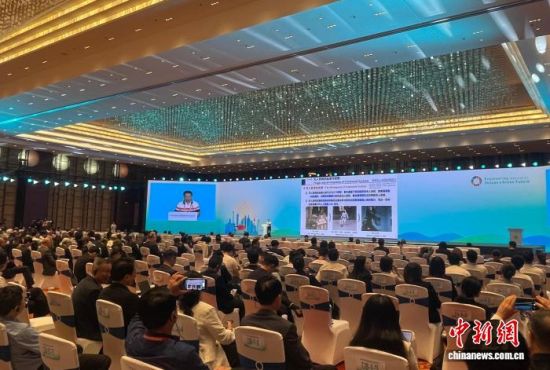The 2025 World Federation of Engineering Organizations General Assembly and Global Engineering Conference was held in Shanghai. During the conference, the “2025 Top 10 Global Engineering Achievements” selected by the Engineering journal were officially released.
The “2025 Top 10 Global Engineering Achievements” are: Antibody-drug conjugates, Blackwell GPU architecture, DeepSeek open-source large language model, Full-ocean-depth manned submersible, High-performance carbon fiber composites, Humanoid robots, Perseverance Mars rover, Euclid space telescope, South-to-North Water Diversion Middle Route Project, and Taklamakan Desert border fixation project.
Since 2021, the Engineering journal and the “Global Engineering Frontiers” project team have jointly organized the annual “Top 10 Global Engineering Achievements” selection activity, aiming to attract social attention to engineering innovation and create a favorable atmosphere that respects engineering and advocates creation.
The “2025 Top 10 Global Engineering Achievements” were determined through global nomination collection, expert selection and recommendation, public questionnaire surveys, and deliberation by the selection committee. The selected “Top 10 Global Engineering Achievements” mainly refer to major engineering science and technology innovation achievements completed and practically verified within the past five years that have generated global impact, including both major engineering projects or key technical equipment, as well as crucial original innovations and breakthroughs in engineering science and technology.
The selection noted that through systematic innovation in model algorithms and engineering optimization, DeepSeek has opened new pathways for exploring artificial general intelligence under resource-constrained conditions. With leading model performance, open and shared architecture systems, and rapidly deployable engineering capabilities, DeepSeek has quickly grown into one of the world’s fastest-growing artificial intelligence applications. Large language models represented by DeepSeek, characterized by “high performance, strong openness, and low cost,” have significantly accelerated the process of AI democratization, reshaped the global artificial intelligence ecosystem, and promoted accelerated intelligence across various industries.
The selection also pointed out that the global humanoid robot industry innovation is entering a fast track of accelerated development. Humanoid robots are expected to profoundly change future human production methods, lifestyles, and social structures.
At the conference’s main forum, multiple experts introduced engineering developments in current hot areas. Experts discussed the new development momentum brought by large language models, intelligent robots, and other technologies, noting that with the continuous advancement of core technologies such as sensors and AI, intelligent unmanned systems will profoundly impact production, living, work, and social governance models.
World Federation of Engineering Organizations
The World Federation of Engineering Organizations (WFEO) is a global non-governmental organization founded in 1968 under the auspices of UNESCO. It serves as the international voice for the engineering profession, bringing together national engineering institutions from over 90 countries. Its mission is to advance sustainable development and use engineering to address critical global challenges.
Engineering journal
An engineering journal is a periodical publication focused on the field of engineering, serving as a vital platform for sharing new research, innovations, and technical knowledge. Its history is tied to the professionalization of engineering in the 18th and 19th centuries, with early journals like “Philosophical Transactions” paving the way for more specialized publications that facilitate peer review and the advancement of the discipline. These journals remain essential for documenting progress and disseminating findings across various engineering specialties.
Global Engineering Frontiers
“Global Engineering Frontiers” is not a specific physical place or cultural site, but a conceptual term representing the cutting-edge of worldwide engineering innovation and research. It refers to the collective efforts and projects, such as developing sustainable energy systems or advanced AI, that push the boundaries of technology. Its history is a continuous, modern narrative of human ingenuity aimed at solving complex global challenges.
Blackwell GPU architecture
The Blackwell GPU architecture is NVIDIA’s next-generation platform for accelerated computing, announced in 2024 as the successor to the Hopper architecture. It is designed to power a new era of generative AI and large language models, delivering a massive performance leap for data centers and supercomputers.
DeepSeek open-source large language model
DeepSeek is an open-source large language model developed by the Chinese company DeepSeek AI, first introduced in 2024. It represents a significant advancement in accessible AI technology, offering capabilities comparable to leading proprietary models while being freely available for research and commercial use. The model’s development reflects the growing trend of democratizing artificial intelligence through open-source initiatives.
Perseverance Mars rover
The Perseverance rover is a car-sized robotic explorer that landed on Mars in February 2021 as part of NASA’s Mars 2020 mission. Its primary mission is to search for signs of ancient microbial life and collect rock and soil samples for a potential future return to Earth. The rover is exploring Jezero Crater, a site believed to have once been a river delta, to understand the planet’s geology and past habitability.
Euclid space telescope
The Euclid space telescope is an ESA-led mission launched in 2023 to investigate the nature of dark matter and dark energy by creating a 3D map of the universe. It is designed to observe billions of galaxies across more than a third of the sky, tracing their shapes and positions over the last 10 billion years of cosmic history.
South-to-North Water Diversion Middle Route Project
The South-to-North Water Diversion Middle Route Project is a massive infrastructure system in China designed to alleviate water shortages in the arid northern regions, including Beijing. Its construction began in 2003 and was completed in 2014, diverting water from the Danjiangkou Reservoir on the Han River. The project spans over 1,400 kilometers and provides a crucial water supply to over 100 million people.




